I can’t go to the gym, so how will I exercise?
Most of the time when we are faced with this question, it’s missing one workout, over the weekend, or away on a vacation. No big deal, we can run an extra 30 minutes when we go back to the gym on Monday.
However, when this turns from short-term to everyday, it’s time to ditch the excuses and learn how to work out from the comfort of your home.
So, what’s best for you?
To determine this, you need to understand your goal. Are you looking to lose weight, gain muscle, tone up, or simply improve overall health? Each requires a different focus but a combination will provide a good starting place for tackling the working from the home hurdle.
Let’s have a look at what we can do with what we’ve got, and what little extras will transform a living room into a gym!
Cardio
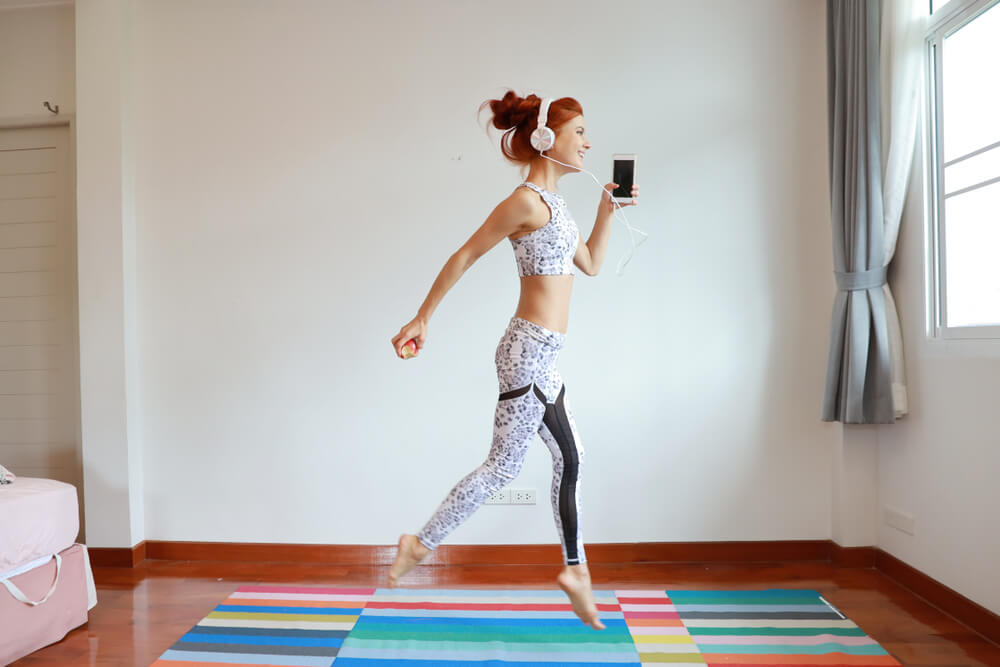
When most people think of exercise, we think of movement. And for most, this means cycling, swimming or mainly running. We go from nothing to a long jog, meanless plodding along the pavement in a bid to burn as many calories as possible only after to feel exhausted and unmotivated to wake up the next morning and do it all over again.
The age-long debate is should we do steady-state or high-intensity cardio?
Both have their place, but recent research has shown that high-intensity interval training, commonly known as HIIT, has a superior afterburning effect.
This is due to the oxygen deficit created from exercise, which leads to post-exercise oxygen consumption (EPOC), which in turn boosts your metabolic rate providing additional calorie burn even when you’re not exercising!
Additionally, although time doesn’t seem a barrier when working from home, it can still have a large influence on motivation. Would you rather wake up early to find the time to fit in an hour jog around the park or a quick 15-minute HIIT session that you can do at lunch or even squeeze in between meetings?
So, where to start?
A great place is YouTube, where you can access a variety of exercise videos to follow.
A good example is Joe Wick, under the handle ‘The Body Coach TV.’ On his channel, he has a good selection of videos to help you on your home fitness journey. Like a 20 minute no equipment workout video. How perfect is that? All you have to do is put it on your phone or tv, and follow what he says! I would warn you though, 20 minutes of high knees and jump squats can quickly fatigue the best of us.
Don’t get disheartened. If 20 minutes is too much, start with 5 or 10 minutes. Then you can set yourself a goal each week to progress. Setting mini-goals like this really help dedication by providing a sense of accomplishment. Chris Foster, Nuffield Health Professional and Head of Fitness, preaches this approach, saying that small goals can help maintain motivation and in turn, provide lasting success.
Now for some, HIIT may sound as scary as the looming end-of-year review coming up with the boss, and we get it. As such, low-intensity state cardio (LISS) may be a better option.
But don’t fear, there are still ways we can get the same calorie burn without having to face the cold, wet weather outside. Cardio equipment, such as exercise bikes, provides a good alternative to the aforementioned running.
Finding the Space for Cardio Equipment at Home
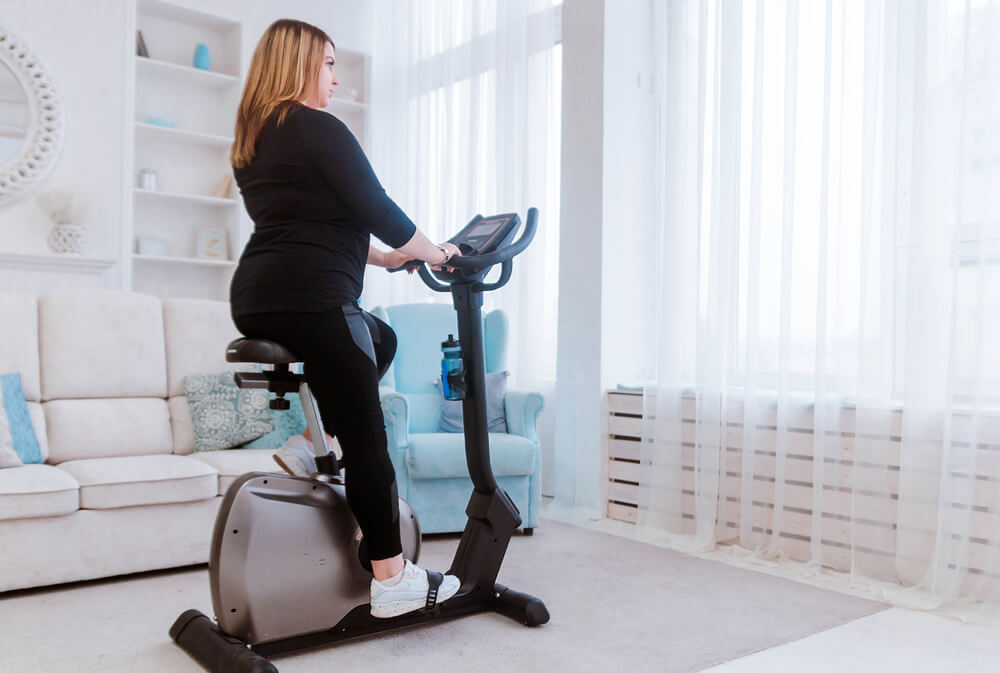
A big problem here is space.
How do I fit a treadmill without it taking over my living room?
Let’s face it, people don’t buy treadmills as pieces of art! It’s not like most people think ‘you know what, I think a treadmill would look nice in the corner of my room.’ It’s safe to say that’s not the case. So this is where equipment that can be stored easily is a good option.
A really great option if space is an issue, and for most it is, is a foldable exercise bike. The Ultrasport F-Bike Home Trainer with Hand Pulse Sensors on Amazon provides a bike that can be expanded to be used in the comfort of your home but at the same time folded into a convenient shape, much like an ironing board!
If space isn’t an issue, then the Peloton could be a good alternative, which offers online classes so it feels like you’re taking part in your local spin class without leaving the house. What’s also great is that Peloton offers a one-month free trial so you can see how much, or little, you will use the bike. For those who love gym classes, and aren’t worried about space or spending a little more, then the Peloton is the way to go.
Weights
Another issue with exercising from home versus a gym is a lack of equipment. You may have a treadmill or an exercise bike, but I doubt most people have a leg press machine or a squat rack tucked away behind the sofa. So what equipment can fit neatly into your home, or even what in your house can be converted into equipment?
A great place to start for gaining or toning muscle is your body weight. Exercises like the pushup for the chest and triceps, the squat for overall leg development, superman for the back, or classic ab movements such as the sit-up or plank.
Whether you’re new to lifting or a regular gym-goer, then bodyweight is always a great place to start. Challenge yourself by slowing the movement down to fully tax your muscles.
If you want to make these moves more difficult, let’s add some extra resistance!
Now, this is where we get creative…
Look around your room and let’s see what we can use. Using bags or suitcases can be a clever way to create weight without much effort. Fill up a backpack with books whilst doing bodyweight movements like squatting or press-ups and you’re going to feel sore the next day.
To take it up a notch, let’s see what can be added to maximize your workout space.
When it comes to adding equipment to your home gym, think versatile. You want something that will provide a myriad of benefits to your training options.
Resistance bands for example are a great addition. They can be used to add resistance to bodyweight movements, like the pushup. They offer new exercises, including shoulder presses, hamstring curls, and several arm exercises such as bicep curls.
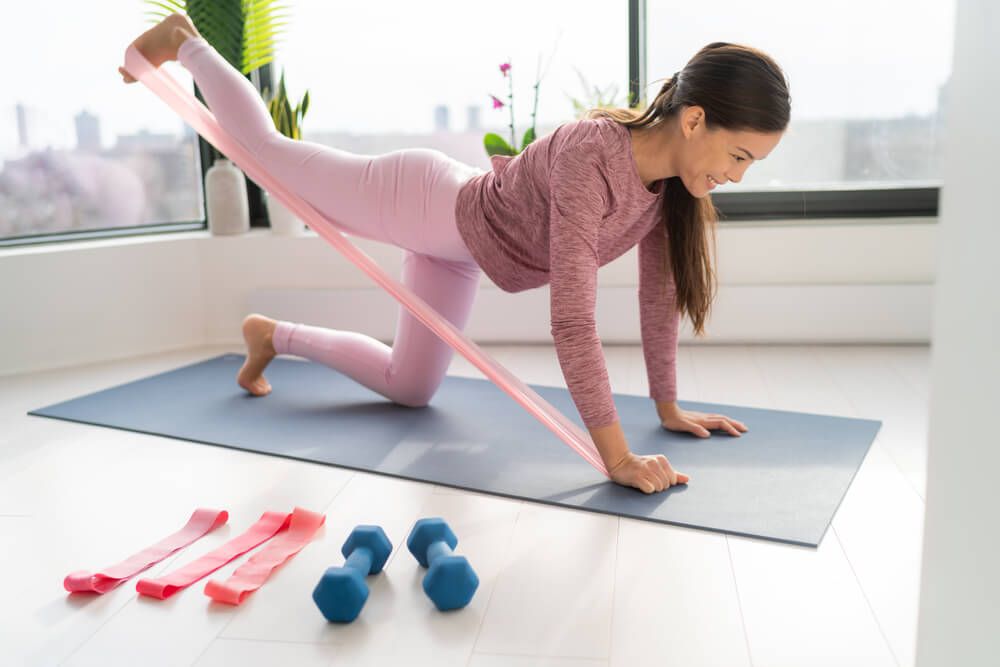
There are several types of bands, so ensure you know what they are before buying! Most importantly, they come in different lengths and resistances.
Lengthwise, if you want to do lateral band walks or clams, essentially exercises that target the glute and hamstring area, then tighter bands are best. If you are looking to implement exercises that require the band to stretch further, think wrapping around the back of your body for a pushup (see below), then longer bands are ideal.
Men’s Health sells a good variety, but this is where resistance, essentially the ‘weight’ of the band is important. For example, these bands range from 15-25lb resistance up to 100-120lbs.
Think about what weight you can move in the gym. Let’s say you can squat 88lb (40kg), if you were to add the 100-120lbs band you wouldn’t be able to lift it! You are even likely to hurt yourself in the process.
Another great tip for buying bands is…
Don’t go off your strongest lift. If you can squat 100-120lbs but can only do chest press for 50lbs, that band is useless unless you are squatting. Think about what will give the most “bang for the buck”. This is the key to utilizing equipment when working from home. Making what you have covered as many exercises as possible.
My final recommendation for strength training would be dumbbells.
Why dumbbells over barbells you ask?
The ability to target body parts unilaterally ensures that your body develops equally. With a barbell, it’s easy for the stronger body part to take over. The variety of dumbbell exercises are vast, including chest press, shoulder laterals, goblet squats, and lunges. What’s also great is that you can implement them into other elements of exercise. If we think back to the HIIT exercises, adding weight to some squats followed by burpees is going to really ramp up the intensity and calorie burn.
A key advantage of dumbbells is again, versatility. Dumbbells that offer the ability to adjust the weight only add to this. They may seem less professional than a normal gym, but unless you’re charging £9.99 for monthly entrance to your living room then I think you will be fine!
Look for ones that allow you to adjust the weight by removing plates. For example, the Opti Vinyl Dumbell Set has a set of 2 x 10kg dumbbells for £24.99. The set includes 8 x 1.25kg and 4 x 2.5kg plates, allowing you to have a mixed variety of weights ideal for different exercises and difficulties. Let’s put it this way, if you buy 10kg dumbbells, that’s it. You can’t make that lighter so then you have to buy more and then you get to the point of spending a lot and running out of room!
Yoga
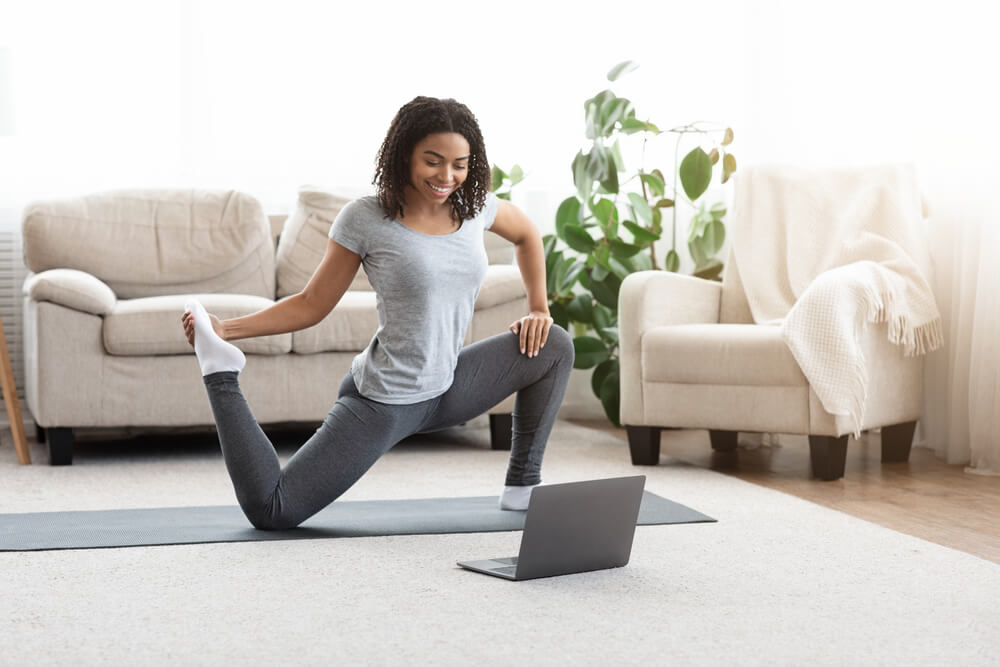
Another great form of exercise you can do from the comfort of your home is yoga.
Realistically, all you need is a yoga mat. And if you really don’t want to get one of those, a towel or a carpeted floor will do.
Working from home places strains on our bodies that we are not used to. Not everyone has the perfect home office, with many of us sitting at a desk not optimally set up for a strong posture that supports healthy spines. Incorrect posture leads to the neck bearing the full weight of your head, which on average weighs more than 5 kilograms.
According to Physical Therapist Jill Henderzachs-Mason, when straining your neck at 45 degrees, for example leaning towards seeing a monitor, forces over four times the stress of your head weight on your neck. Due to this, the upper body tries to overcompensate for the pull of gravity on our head, which leads to the back being put in an unnatural position for sustained periods. This can cause discomfort in the middle and lower backs.
No wonder many people suffer symptoms such as stiff necks, headaches, and aching lower backs. Working from home, therefore, is a key culprit in causing poor posture. To highlight how damaging this can be for us, imbalanced posture causes improper joint alignment and forces muscles to work harder than they should to a detrimental effect, leading to injuries.
To combat this, greater flexibility and counter movement patterns should relieve the stress caused by hunching shoulders and a stooped neck towards our computers. We want movements that will pull your shoulder blades backward and straighten our posterior chain – cat-cow, thread the needle, and the sphinx pose are good examples of how we can alleviate and undo the desk-bound damage of working from home.
Additionally, a lot of discomfort in our posture can be caused by tight hips. Great exercises to stretch the groin include a variety of animal poses, including the pigeon pose, lizard pose, and frog pose.
Work your way up to some of the harder movements, but also ensure that you hold the stretch for long enough. Around 30 to 60 seconds so that the body can start to relax and fully lengthen in the stretch position.
So what’s stopping you? This article has now given you a solid start on how to turn your house into a fully functional gym. When it comes to achieving your workout goals, the best time to start is now. Pick what gets you excited from the above, and get to it. Before you know it, you won’t ever need to exercise anywhere else!


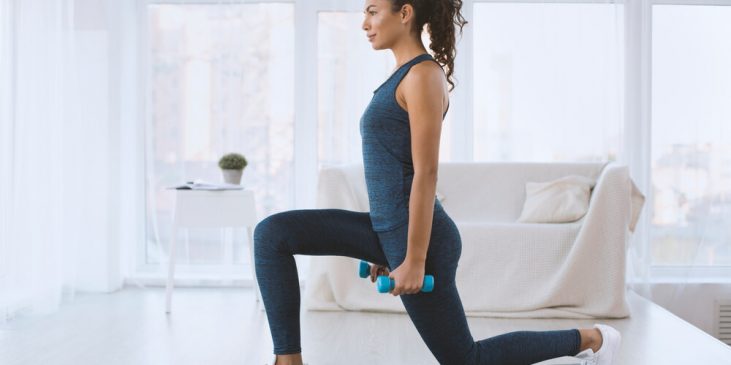
0 comments on “How to Stay Active in the Winter, Without Going to the Gym”